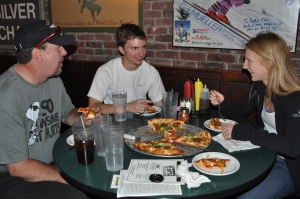It’s hard to read your Facebook news stream and not see an abundance of ALS Ice Bucket Challenge videos. Don’t get me wrong, it’s a fun promotion raising awareness and resources for a good cause. But for those of you balancing a career and raising children, I have a different challenge for you: The Dinner Challenge. No need to pour freezing water over your head or post a video; instead, the next time you are dining out, look around you. Scan across the restaurant at other tables and notice the interaction amongst family members. What you see may shock you—or perhaps resemble you.
On several occasions, we’ve observed entire meals with each person at the table independently engaged with a mobile device, phone or game, almost oblivious to one another. Families, from the point of sitting down to when the food arrives—and sometimes while eating—electronically plugged in and sadly devoid of conversation, completely alone while sitting together. We live in a technologically advanced age with connectivity at our fingertips and yet we are a society starved for connection: human relationships. The art of conversation. Genuinely enjoying being with one another. We spend our days building professional communities yet our family communities are slowly drifting away.
As parents and working professionals, we have the power to change that. As simple as making a commitment to eating a meal together as a family and using this time to talk and interact, you can begin to reverse the disconnected trends and make a positive difference where it matters most. Challenged by the thought of family dinners? You are not alone. In the past 20 years, the frequency of family dinners has declined 33%, replaced by busy schedules and structured activities outside the home. (source: NYU Langone Medical Center) But in the interest of raising confident, healthy kids with strong family values—our future workforce—I urge you to make family meal times a priority. Drawing from my own mistakes and successes, here’s what I’ve learned along the way for maximizing our time together:
Unplug during meals. At our house, we have tech curfews and boundaries. This includes the table. No phones. No texts. No TV. Facebook can wait. Make meals a community occasion—your time to spend 30 quality minutes with undivided attention to each other!
Eat at a table. Even if you’re eating take-out, resist the urge to eat on the couch or in front of the TV. Not only is it just easier to eat at a table, but a table is also more conducive to conversation.
Make the table a “safe zone.” Fear of correction, judgment or criticism kills the desire to participate. If you want your kids to enjoy family meals, avoid correcting, criticizing, arguing or nagging during meals. Instead, talk about fun topics—sports, positive events from the day—and be genuinely interested in the things your kids want to share, good, bad or beyond you. Our son enjoyed talking about his favorite class…physics! I have to be honest. Physics is one of those “beyond me” subjects; it’s just not my thing. But listening to his excitement and watching his enthusiasm as he shared, I couldn’t help but be interested and engaged in the conversation. Over time, your kids will look forward to meal times for reasons other than the food.
It’s never too late to start. Maybe your kids are older. Or your work schedule is demanding, requiring long hours. It doesn’t matter. I encourage you to start somewhere, even if it’s small. Make a commitment (and keep it) to eating together two nights a week. If dinner doesn’t work, target lunch or breakfast. Start with a manageable schedule and once you’ve established a pattern that works, look for opportunities to expand your frequency.
I cannot encourage you enough: engage with your kids. Take an active interest in who they are; invest in family togetherness. There’s plenty of time to work and climb the corporate ladder, but our family time will eventually come to an end. Yes, there will be times when you question if your efforts are really making a difference. But one day, when you least expect it, you’ll know it was all worth it. Before our daughter left home to start school at Montana State University, she asked if she could call in for family dinner times. I smiled as she unknowingly confirmed our family meals were less about food for the body and more about refreshment of the soul.
To everyone reading this post, I nominate you: take The Dinner Challenge. You’ll be glad you did.



